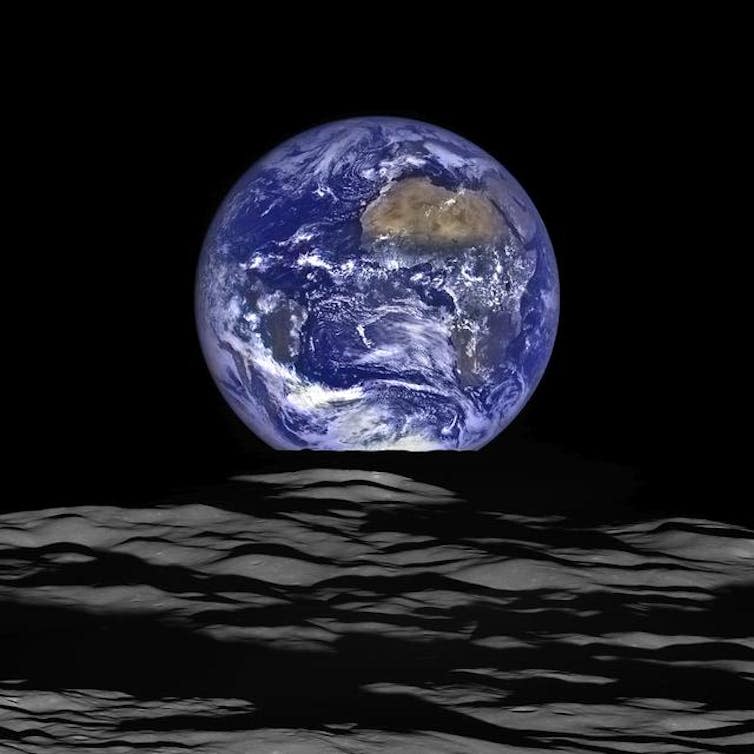The new romantic comedy Fly Me to the Moon tells the story of how NASA hired an ambitious marketing specialist to boost public support in the run-up to the Apollo 11 mission.
The history books tell us that this isn’t quite what happened, but I believe modern science communicators can still learn from this irreverent revision of NASA history.
In the opening scenes of Fly Me To The Moon, Kelly Jones (Scarlett Johansson) is recruited by shady government officials to sell one of the biggest things you can sell: the moon. The premise may seem far-fetched.
After all, who doesn’t already love the moon? Why should we sell the exciting prospect of a man landing on it anyway? In 2024, we’ll look back on the 1969 lunar mission through rose-colored glasses.
In reality, the majority of American citizens in the 1960s felt that the enormous cost of the Apollo missions was not worth their money. “Americans are past their long and very expensive honeymoon in space,” Jones tells a skeptical NASA employee cheerfully. “I’m here to remind them why they fell in love in the first place.”
As she embarks on her mission to collect the human stories behind Apollo 11, Jones encounters resistance from NASA staff, concerned that her efforts will undermine the science. The launch director tells her, “My boys are too weird for interviews, and they’re really busy doing life-and-death work.”
Despite her resistance and hostility, she begins to make up her own stories. About engineers with rocket fuel in their blood and a childhood love for the stars, and about a director whose father, a pilot, died on the job.
Scientific skepticism
Next year, NASA plans to launch its Artemis 3 lunar mission, the first time in nearly 50 years that humans will land on the lunar surface. But things aren’t the same as they were in the 1960s. The further we get from Neil Armstrong taking a small step, the stronger public support for a return to the moon has become.

That doesn’t mean there’s support for all areas of science. On Earth, pandemics and the existential threat of climate change have underscored the importance of how people think and communicate about science. Sometimes, misinformation and science denial win in parts of the U.S. So can scientists learn from PR and marketing professionals?
Research in cognitive science shows that people remember certain stories and pass them on more faithfully, better, than others. We particularly remember human stories that involve social relationships and motivations, counterintuitive stories that surprise us, and negative stories in which nothing good happens.
For example, when telling the story of Apollo 11, as a communicator you can emphasize counterintuitive aspects, such as the fact that a modern smartphone has over a million times the memory of the computer on board Apollo 11. Negative aspects can also be emphasized, such as the astronauts who tragically died in the Apollo 1 disaster, or more social aspects of the scientists and engineers behind the scenes.
Marketing professionals and journalists have known about and used these cognitive biases for a long time. And it seems that conspiracy theorists are also taking advantage of these tricks.
I challenge you to find a conspiracy theory that isn’t counterintuitive, or about complex social motivations, or about bad things happening. So, if they’re using disinformation marketing tricks, shouldn’t we be using them more often in communicating science?
Professional restraint?
How do science communicators feel about using such tricks? My own ongoing research, funded by the British Academy, is trying to find out.
I interviewed 19 science communication professionals who use storytelling in their practice, including writers, filmmakers, digital content producers, and live presenters. I asked them whether they use cognitive biases in their storytelling and, more interestingly, what prevents them from taking advantage of these tricks.
Although the study has not yet been published, science communicators told me that they sometimes worry that introducing counterintuitive stories or human characters into their communications could detract from the science. This is similar to what the people at NASA said in the film.
That is understandable. Keeping information in the audience’s memory is an important aspect of science communication. But there are often other objectives that can be contradicted when you try to achieve this.
The clearest example of this is the bias toward negative information. Science communicators may worry that if they make their stories too negative, people will become discouraged, too fearful to take action on issues such as climate, or that they will disengage from science altogether. However, negative emotions can be an important step in the emotional journey toward activism.
Other contradictions are more subtle. Information sticks in our brains when we understand the relationships and motivations of the people involved. But the science communicators told me they worried that this framing might contradict the goals of sending certain messages.
For example, science is often a collective endeavor involving large teams. It is probably the scientific method, not the individual researchers, that makes science successful. Science communicators often avoid overemphasizing individual responsibility or opinion.
Another problem may be that too many characters or counterintuitive elements can make science communication too complex. This would conflict with the goal of making something very complex easy to understand.
I can understand why it is sometimes difficult to “sell” science using the same methods as in marketing. But when I saw Fly me to the Moon, I wondered if a little inspiration from the field might be useful in communicating science.
This article is republished from The Conversation under a Creative Commons license. Read the original article.
Hannah Little receives funding from the British Academy.